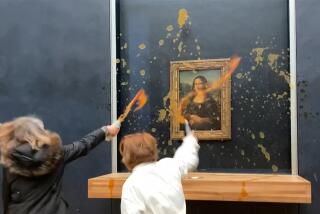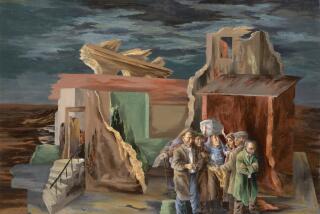Canadians Incensed by Purchase of U.S. Art : Art: Ottawa’s National Gallery spent $1.5 million on a Barnett Newman abstract. The community protests that the money could have been spent in support of Canada.
- Share via
TORONTO — Outside the arts community, people often say they have trouble finding meaning in Abstract Expressionist painting. But not so the Canadians who have had a look at Barnett Newman’s 1967 painting “Voice of Fire.” They are finding all sorts of symbolism in the late American’s work, now hanging in the Canadian National Gallery in Ottawa.
The trouble is, it isn’t the sort of meaning the artist--or the gallery’s curators--would have wanted to evoke.
“This really highlights the state of our economy,” one Canadian, Gord Mountenay, says of the canvas, which stands 8 by 18 feet and shows a red stripe and two blue stripes, no more, no less.
Mountenay, a 30-year-old civil engineer from Almonte, Ontario, has not seen the painting. But he said in a recent letter to the editor of the Ottawa Citizen that he read in the newspaper of its acquisition, in an article published on the same page as an account of a child who needed a heart and lung transplant and who died while her family and neighbors scrambled for funds.
“It’s not hard to understand why inflation rates are high, interest rates are high, economists are forecasting recession, et cetera, when this type of ludicrous spending of taxpayers’ money is allowed to go on,” complained Mountenay, himself the father of two small children.
Canadians are known as a people slow to anger, and so National Gallery spokeswoman Helene Murphy says she never dreamed her compatriots would rise up the way they have after she sent out a press release on the painting’s acquisition earlier this month. The gallery bought “Voice of Fire” from Newman’s widow for $1.8 million Canadian--or about $1.5 million in U.S. currency--out of a total yearly acquisitions budget of a little more than $2.5 million.
“In my view, it wasn’t news, so I put out this little press release, and bang !” Murphy recalled. The events that have followed show that one thing that does outrage Canadians in the 1990s is cultural incursion by the United States--especially when funded by Canadian tax dollars.
Already, Felix Holtmann, a Manitoba hog farmer who is chairman of the culture committee in Canada’s House of Commons, has gone on a radio phone-in show to announce that he would call National Gallery officials before the committee and demand an explanation.
“It looks like two cans of paint and two rollers and about 10 minutes would do the trick,” Holtmann harrumphed.
Indeed, John Kirton, of Kinburn, Ontario, another letter writer to the Ottawa Citizen, thought a little hog farming might do the free-spending aesthetes at the National Gallery some good.
“As one who has earned his bread with the sweat of his brow for 60 years and contributed to Canada’s economy, it hurts me to see how the supposed experts so easily squander the taxpayers’ dollar,” Kirton said. “It is my personal opinion those experts should be shipped off to some remote hog farm and set to work shoveling until every last cent squandered is repaid.”
Other Canadians are rallying to the cause as well. In Ottawa, one entrepreneur is offering a short-sleeved cotton T-shirt emblazoned with three stripes, for $20,000. And John Czupryniak, a house painter in the Ottawa suburb of Nepean, has erected a massive knock-off of “Voice of Fire” in his yard, propped up against his fence.
“It took a whole day to do,” Czupryniak reported. “Everybody loves it.”
Part of the problem, of course, is the age-old distance between the come-what-may lovers of high art and the practical-minded. Barnett Newman belonged to the Abstract Expressionist school of painting, which flourished in New York after World War II and included Jackson Pollock, Mark Rothko and Clyfford Still.
The movement was hardly accessible to many gallery-goers; its adherents tried to throw out old conceptions about paint, canvas and the sheer act of putting oils on canvas, and they created radical images intended to challenge their viewers to think about what it meant to paint.
“You could have a totally white canvas, or a totally black canvas,” Murphy explained in an interview. Newman, for one, at age 43 began to examine the stripe--or the “zip,” as he called it--and did so for months. In the end, he accepted it as an emblem of himself and painted “zips” of various colors, textures and sizes for the rest of his life.
Exhilarating stuff, to some.
“It’s about striving. It’s about creation. It demonstrates that, yes, there is still a world of spirit out there,” Murphy said. For her, she said, looking at “Voice of Fire” has an effect much like the contemplation of a Gothic cathedral. For others, she conceded, it may be something less.
Abstract Expressionism “is not exactly easy for people to get their hands on,” she noted.
But it isn’t simply the unschooled who object to the three big stripes in the National Gallery. Art critic John Robert Colombo of Toronto, who has written extensively on Canadiana, has added his voice to the chorus calling for the painting’s return to America.
“The issue, if you wish, is cultural sovereignty,” he declares.
Cultural sovereignty has been an on-and-off issue in Canada for a century, and it was brought back to the boiling point about a year ago, when Canada signed a bilateral trade pact with the United States. In essence, the pact was supposed to tear down tariff walls between the two North American neighbors and set up an orderly means for resolving trade disputes. But many Canadians think free trade will lead to a tidal wave of American arts and entertainment washing over the border, drowning out Canadian voices.
In the visual arts, Colombo says, that would mean America’s predilection for the abstract would overwhelm Canada’s preference for the representational.
“You might not see this, but it is one way in which the Canadian cultural tradition is different from the American one,” he said. He added that he thinks the National Gallery should have spent its money building its Canadian collection.
To make matters worse, free trade with the United States is coming at a time of shrinking federal and provincial budgets in Canada. Many Canadians assume their artists and writers need government subventions to stay on an even footing with their American counterparts, since the Canadian economy is only one-tenth the size of the United States’ and cannot support the arts without direct government help. Now, however, the government is cutting back.
The Northern Native Broadcasting Service, for instance, which beams non-English radio and television programming into the far north, is losing much of its funding. Canadian magazine publishers are worried about reductions in postal subsidies for their publications, and the possibility that they will not be able to compete with Time, Newsweek and others.
More to Read
The biggest entertainment stories
Get our big stories about Hollywood, film, television, music, arts, culture and more right in your inbox as soon as they publish.
You may occasionally receive promotional content from the Los Angeles Times.










